Do you want your company’s products to be successful and popular? Well, an amazing design is simply not enough.
Even if your team creates a high-quality product, it won’t matter much if it doesn’t reach your audience at the right time and persuade them to buy it.
That’s why the product launch is one of the most important aspects of creating a new product.
Read on and find out how to get it just right.

In this article:
What is a product launch?
A product launch is the process of bringing a new product or service to the market.
The main goal of the product launch process is to:
- Raise brand awareness and
- Build anticipation among target customers.
If you succeed, you will ultimately make sales and earn a profit.
When launching your product, you can rely on 1 of the 2 main types of product launch strategies:
- Hard launch — a formal release of a market-ready product, released with full-force efforts from the very first day. It comes as an important announcement after a period of creating hype among the target audience.
- Soft launch — a more subtle release that doesn’t include any formal announcements. It can be in the form of a gradual release of certain product features or components that precede the grand release of a fully developed product. Alternatively, it can include releasing a new product to a limited audience, and then fine-tuning it, based on their user experience.

How to launch a product successfully in 7 steps
Though every product launch process varies depending on the product type, there are some general steps to follow to stay on track.
So, if you’re not sure where to start, we suggest the following 7 steps. Of course, you can always alter or add something to adjust the process to your needs.

#1 Create a product launch roadmap
The very first step is to create a product launch roadmap — a visual display of your plan.
The product launch roadmap should contain the broader plans and goals of the launch. Don’t bother with the details yet — there will be time for that in the following steps.
This roadmap will help you manage the entire product launch process, from the pre-launch to the post-launch stage.
It will also keep all teams and team members aligned, starting from the product and development teams all the way to the marketing and sales teams.
Since launching a product is a complex process, you’ll probably want to save some valuable time on making the roadmap from scratch.
To do this, you can use a pre-made product launch template, such as the one available in Plaky, our project management software.
Get our product launch template
To better illustrate what the product launch roadmap looks like — here’s an example:
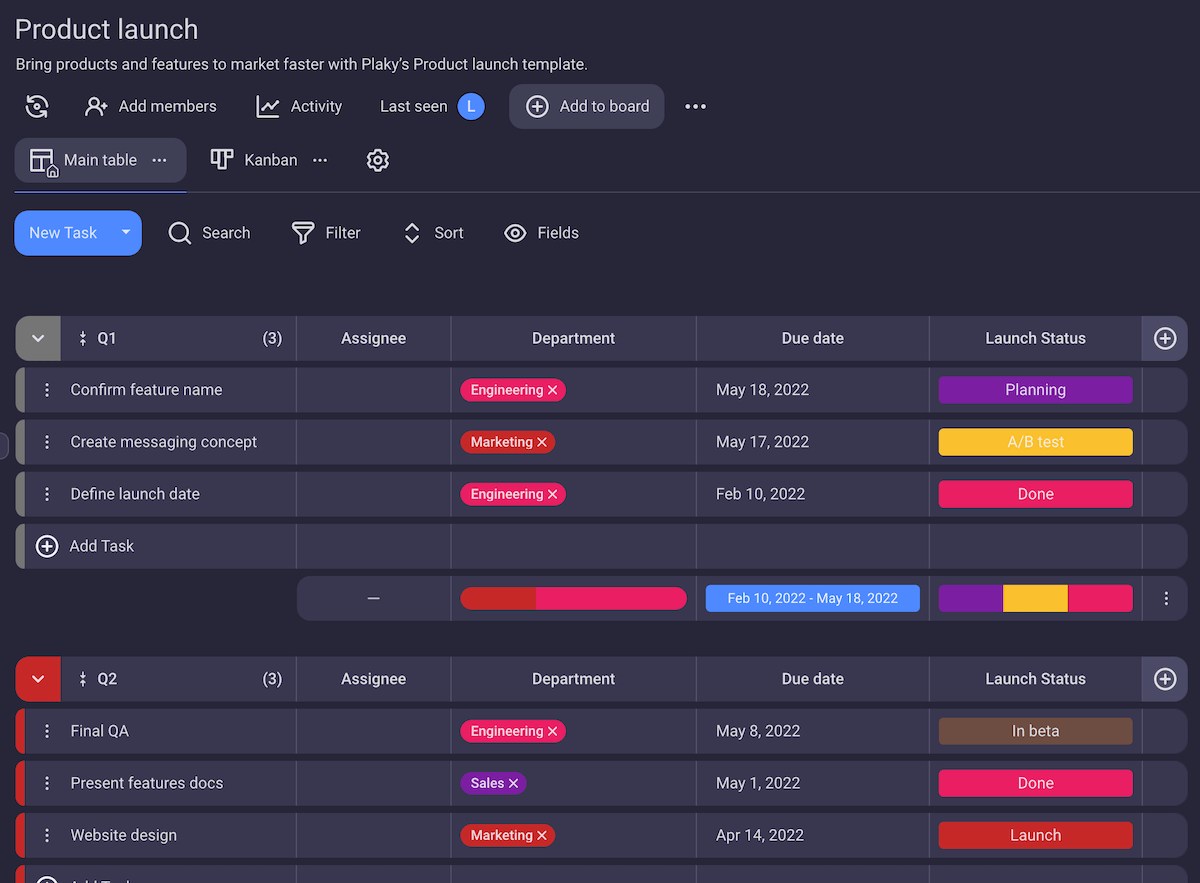
In the example above, you can see how you can easily organize different tasks into groups (e.g. Q1, Q2) and add customizable fields, such as:
- Assignee — to assign one or multiple team members to different tasks,
- Department — to assign different teams, such as sales or marketing teams,
- Due date — to define task deadlines, and
- Launch status — to keep track of ongoing tasks with colored status labels, such as In Beta or Done.
💡 Plaky Pro Tip
If you’re looking for more examples of different product roadmaps that don’t necessarily focus on the launch, check out this article:
#2 Track the launch process with a product launch checklist
Another great addition to your product launch planning process is — a checklist.
This simple way of keeping track of the launch is more effective than it initially appears.
Using a checklist works wonders as you can easily tick the task you’ve done and move on to the next one — without getting overwhelmed by too much information at a time.
The biggest advantage of using a checklist for a product launch is that you can include a wide variety of tasks in it, whether simple or complex, e.g.:
✅ “Enter the due date for the ‘design website’ task in Plaky” or
✅ “Finish website design”.
Here’s a free checklist template you can use throughout your product launch:
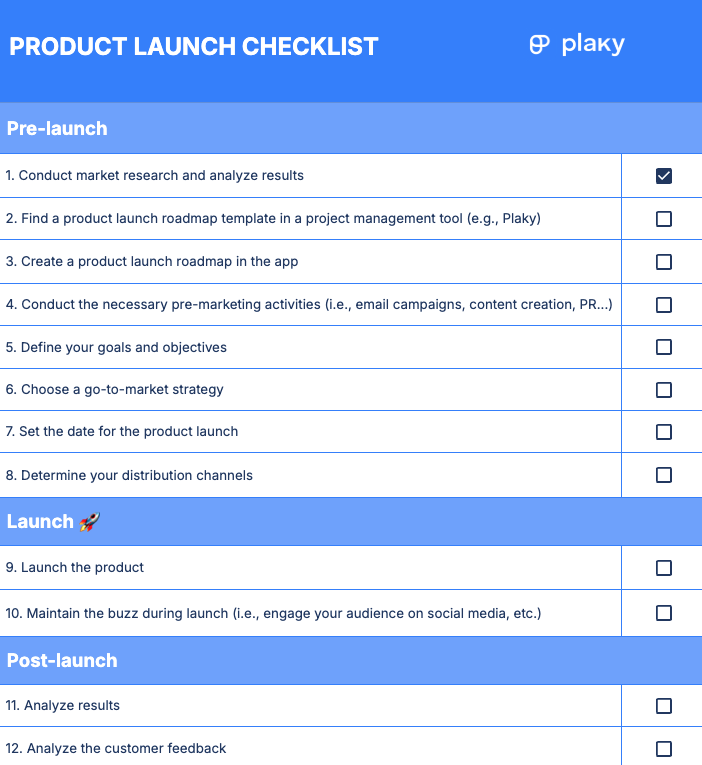
Get our product launch checklist template
#3 Engage in some pre-launch marketing
Pre-launch marketing is a must since it’s your chance to create hype around the upcoming product as well as test different marketing channels.
Gathering feedback about the product in advance will also help you make any necessary changes before the final product launch.
Pre-launch marketing strategies can include:
- Email promotion,
- Content marketing, and
- PR.
Altogether, pre-launch marketing will prepare the target audience for the launch by creating a sense of curiosity. Plus, it’s likely to create a waiting list of your first paying customers.
And it really doesn’t have to be anything too complicated. Even a simple countdown timer on your website or social media page coupled with compelling copy could raise anticipation and create some seriously positive buzz around your upcoming product.
#4 Set your product launch goals
Another important step in launching a new product on the market is setting clear goals.
Without defining S.M.A.R.T. goals, it will be harder for you to reach your desired outcomes, as you’ll end up aimlessly wandering through the vast market. So, be sure to set both long-term and short-term goals.
When it comes to different goal types, they can be:
- Revenue-oriented (e.g., looking to profit from the launch),
- Market-oriented (e.g., searching for the right market to fit your product),
- Customer-oriented (e.g., targeting the appropriate consumer base), or
- Brand-oriented (e.g., raising awareness about the product).
Whichever the case, it’s always good to know exactly what you want to achieve and where you want to see your product in the future.
#5 Define your distribution channels
When deciding which distribution channels to use, you can rely on market research, which will provide you with data on how target customers buy similar products.
Decide how you’ll distribute your product depending on the market and your target audience’s preferences. There are 2 ways to do it:
- Directly — by selling the product to the customer (e.g., in retail stores or through door-to-door sales), or
- Indirectly — with one or more intermediaries included, such as a distributor or a wholesaler.
The decision will mainly depend on the size of your business.
Usually, smaller companies opt for direct distribution channels as those allow them to have a closer relationship with their customers. This type of distribution is perfect for software companies or small-scale manufacturers, for example.
On the other hand, larger companies often use more complex, indirect distribution channels, such as:
- Manufacturer—retailer—customer sales, or
- Manufacturer—wholesaler—retailer—customer sales.
Indirect distribution is well suited for companies with mass production, such as clothing or cosmetics companies.
#6 Launch the product
Now, the time has finally come for you to launch your product!
However, this step doesn’t just cover the moment the product is launched, but also the days and weeks that follow.
You should focus on maintaining the excitement about the release for as long as possible — usually through marketing.
For example, a proven way to keep people interested during the product launch is to use social media.
Here are some marketing tips to help you at the execution stage of a new product launch:
- Reply to comments on any posts mentioning your new product to increase your reach and show that you listen to your customers and care about their opinions.
- Collect testimonials, as it’s easier for potential customers to build trust when they know others have successfully used your product.
- Create giveaways through which potential customers can try your product for free.
After all, the longer the buzz — the better the sales.
#7 Complete post-launch activities
The post-launch stage is everything that happens after you’ve launched the product.
It includes tracking both how well your product has been received by the target audience — and the objectives you’ve met as a company.
You can measure the performance of your product launch using metrics specific to your product.
Apart from measuring success, the post-launch stage includes a range of other activities, such as:
- Content publishing — To keep the target audience engaged, you can post various types of content, such as how-to guides for your product, behind-the-scenes videos, or additional tips and tricks on product features,
- Analyzing the product launch results, customer feedback, as well as financial results, to allow improvement in the future,
- Making additional changes based on the received feedback,
- Making plans for the future (e.g., new features introduction), and
- Celebrating the product launch.

Bonus: How to launch a new product online
Since more and more people shop online these days, you should absolutely be present online and try to grab a piece of this booming market.
While you should still do everything we mentioned above, here are some additional steps to help you successfully launch a new product online:
- Find influencers or current customers that can provide honest reviews of your product — Satisfied customers are the best advertising tactic you can use. So, reach out to your current customers and ask if they would like to try your new product for free and give a review. Alternatively, collaborate with influencers to reach a wider audience.
- Launch a social media campaign — Create accounts on all major social media platforms and, most importantly — be active! Share pictures of new products and fun facts, and remember to remind customers of your launch date or discounts. Also, consider paying social media ads to reach as many people as possible.
- Tell your company’s or your product’s story on your website — Tell your customers about your company’s journey, what values you uphold, explain how this new product came about, etc. This will help your target audience connect with you and become interested in your product.
Best practices for managing a successful product launch
Along with those 7 steps, here are a few additional practices that’ll polish your strategy and bring it to the point of perfection.
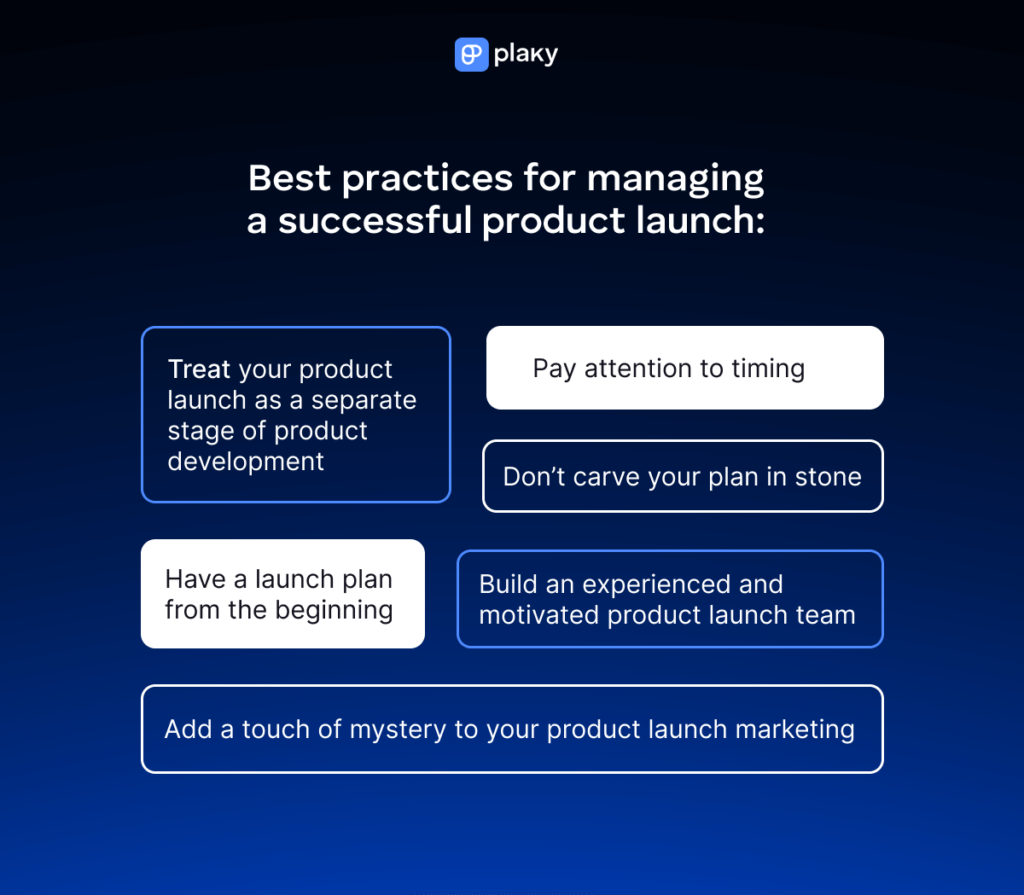
#1 Treat your product launch as a separate stage of product development
You should treat the product launch as equally important as any other part of the product’s life, such as the concept creation or the development stage.
Paying extra attention to the product launch stage and how you manage it directly influences the product’s success or failure, as it is the one that calls for the heaviest investment.
💡 Plaky Pro Tip
Find out more about the stages of the product development process and how to measure its success in the post below:
#2 Have a launch plan from the beginning
Having a step-by-step product launch strategy plan from the very beginning will help both team members and stakeholders stay aligned with what you plan to achieve.
A good way to plan the launch is to use pre-made product roadmap templates, such as the one by Plaky we offered above, or simply rely on product launch checklists.
Whichever option you choose, it’ll surely pay off since planning helps you minimize any potential hurdles and leads to success.
Create a product launch plan in Plaky
#3 Don’t carve your plan in stone
Though having a plan is crucial for success, there’s no better plan than a flexible one. After all, life isn’t perfect, and therefore, can’t be planned in detail in advance.
So — have a plan, but be prepared to change it if and when necessary.
#4 Build an experienced and motivated product launch team
Assembling a strong team is a must if you want your product launch to be a success.
Try to build a team that’s both experienced and willing to collaborate. Choose product managers and team leaders with special care, as they are usually the glue that brings the team together, both in the good and in the difficult times.
Also, support your team and provide them with the necessary training so that they can be prepared for any challenge that awaits them.
#5 Pay attention to timing
Good timing is a critical factor in determining the product launch’s success. After all, you’ve only got one chance to launch your product — so you should pay extra attention to choosing the right launch date.
Make sure to launch your product when:
- There’s a dire need for your product or service on the market.
- Your product is fully functional — You don’t want to rush into launching a product too early and suffer undesired technical or functionality issues.
- You’ve grabbed enough attention for the upcoming product with pre-marketing, and the target audience is aware of the upcoming release and is expecting it.
#6 Add a touch of mystery to your product launch marketing
When it comes to the marketing you do in the pre-launch stage — you can think of creative ways to grab your customers’ attention and somehow stir their imagination.
Mystery has always been a powerful marketing strategy to engage customers and emotionally connect them to your brand.
So, why not let them guess what new product/feature is being released based on clever marketing?
Make them struggle a bit, thinking: “What’s all the hype about?”, “What’s the secret?”, and “What could it be?”
Just as Stephen Brown says in his article on retromarketing: “Torment your customers (they’ll love it)”.

How to measure a product launch’s success
Any good product launch plan should also come with a system to measure its success.
Metrics of success, also known as key performance indicators (KPIs), are an important part of your product launch strategy as they help you understand how your product is performing. This gives you a chance to further improve:
- Revenues,
- Product adoption,
- Customer engagement, and
- Customer satisfaction.
You should choose your KPIs with care — each new product is unique, hence it has unique KPIs.
Here are some examples of KPIs common for all new product launches.
#1 Pre-launch signups
Keeping track of the signup numbers during your pre-launch campaign is important, as it gives you some information on how your product launch is likely to perform beforehand.
Plus, you can assemble a waiting list of leads that might become your paying customers.
#2 Website traffic
Keeping track of the website traffic will give you some insight into the organic vs. paid traffic your product’s website is getting from search engines.
This information will allow you to assess your content quality and improve it if necessary.
#3 Social media traffic
The social media traffic metric is used for analyzing engagement rates of your social media content across different platforms (e.g., videos, podcasts, posts, etc.), as well as the reach you acquire on social media.
As social media is one of the most powerful marketing tools at the moment, you should devote special attention to this metric.
#4 Lead generation
Lead generation measures the number of new leads (i.e., prospects) who’ll potentially become paying customers.
Generating leads is especially useful during the pre-launch as it allows you to predict customer rates.
#5 Conversion rate
You can also measure the number of leads who turn into paying customers — this process is called conversion.
To do this, you can calculate the exact percentage of customers that came from your website, social media platforms, or your other marketing efforts.
Here’s a simple conversion rate formula:
Conversion rate percentage = Conversions ÷ Total number of visitors × 100
15% conversion rate = 15 conversions ÷ 100 website visits × 100
#6 Email open rate
The email open rate tracks the number of users who opened your emails, compared to the total number of people you sent them to.
Here’s an example of a simple email open rate formula:
Open email rate = Number of opened emails ÷ number of delivered emails × 100
20% open email rate = 200 opened emails ÷ 1000 delivered emails × 100
#7 Clickthrough rate (CTR)
The clickthrough rate calculates the number of clicks you got on a specific link compared to the total number of users who viewed your email campaign.
Use this simple formula to calculate the CTR:
CTR = Number of clicks ÷ number of opened emails × 100
15% CTR = 30 clicks ÷ 200 opened emails × 100
#8 Costs and revenues
This may be one of the most important KPIs, regardless of the type of product you’re looking to launch.
Before diving into the realization of your launch plan, think about some strategic budgeting methods to keep your launch costs under control.
Also, you’ll need to calculate how much you’ve invested compared to what you’ve earned to determine if your launch has been financially successful.
💡 Plaky Pro Tip
Do you want to learn how to avoid cost overruns? Read our article:
#9 Customer retention rate
The customer retention rate tracks the percentage of the existing customers who remain with you after a certain period.
This can help you understand what keeps your existing customers loyal to your company, as opposed to what causes them to leave.
To calculate the customer retention rate, you must:
- Find out how many customers you have at the end of a given period (week, month, or quarter) and subtract the number of new customers you’ve gained during that period,
- Divide that number by the number of customers you had at the beginning of that period, and
- Multiply the final number by one hundred.
It sounds complicated, but it’s actually really simple. Here is an example to help you understand it:
(1200 customers at the end of January – 300 newly acquired customers) ÷ 1,000 customers you had at the beginning of January × 100 = 90% retention
What makes a product launch successful?
The primary goal of a product launch is usually to promote the product and drive sales to bring profit to the company.
However, making money isn’t the only thing that determines if a product launch is successful.
Some other possible outcomes of a successful product launch, besides an immediate increase in revenue, include:
- Raising brand awareness,
- Drawing attention to your company, and
- Promoting your other products.
These outcomes have a direct influence on building trust with your target customers, which indirectly drives sales in the long run.
That said, even when launches are not profit-oriented at first glance, don’t be tricked into thinking that they’re pointless.
Whether directly or indirectly, successful product launches will drive sales.
So, if you’ve chosen the right target audience, and your product is solid — you’ll most likely pick the fruits of your labor and enjoy a growing revenue in due time.
Just be patient.

Launch every product successfully with Plaky
If you want to organize your product launch to perfection, you need project management software to help you.
With our PM tool, Plaky, you can create a simple, yet visually effective checklist. Just add tasks with the status field and (optionally) assignee, and you’re good to go.

What makes Plaky a great solution for tracking product launches is that you can keep all information relevant to the product in one place: checklist, roadmap, product launch goals — you name it.
You can create a separate board for each of them and keep them in the same folder. This way, all the information related to a particular product will be in the same place but still well organized and easy to navigate.
What’s more, all of Plaky’s boards are completely customizable, allowing you and your team to:
- Organize key data and include all relevant launch information in various ways using custom fields,
- Quickly pinpoint pending or delayed tasks by sorting, grouping, and filtering the items, and even
- Choose your preferred data overview by opting for one of 3 board views — Table, Gantt, or Kanban.
Plus, Plaky’s robust item cards help you keep related information neatly together, even on task level. For example, you can add files to item cards to enhance file-sharing throughout your product launch — and keep all documents in one centralized hub.
There’s also a comments section in every item card, where you can leave comments, @mention team members, and react to their updates to give feedback or ask for assistance quickly.
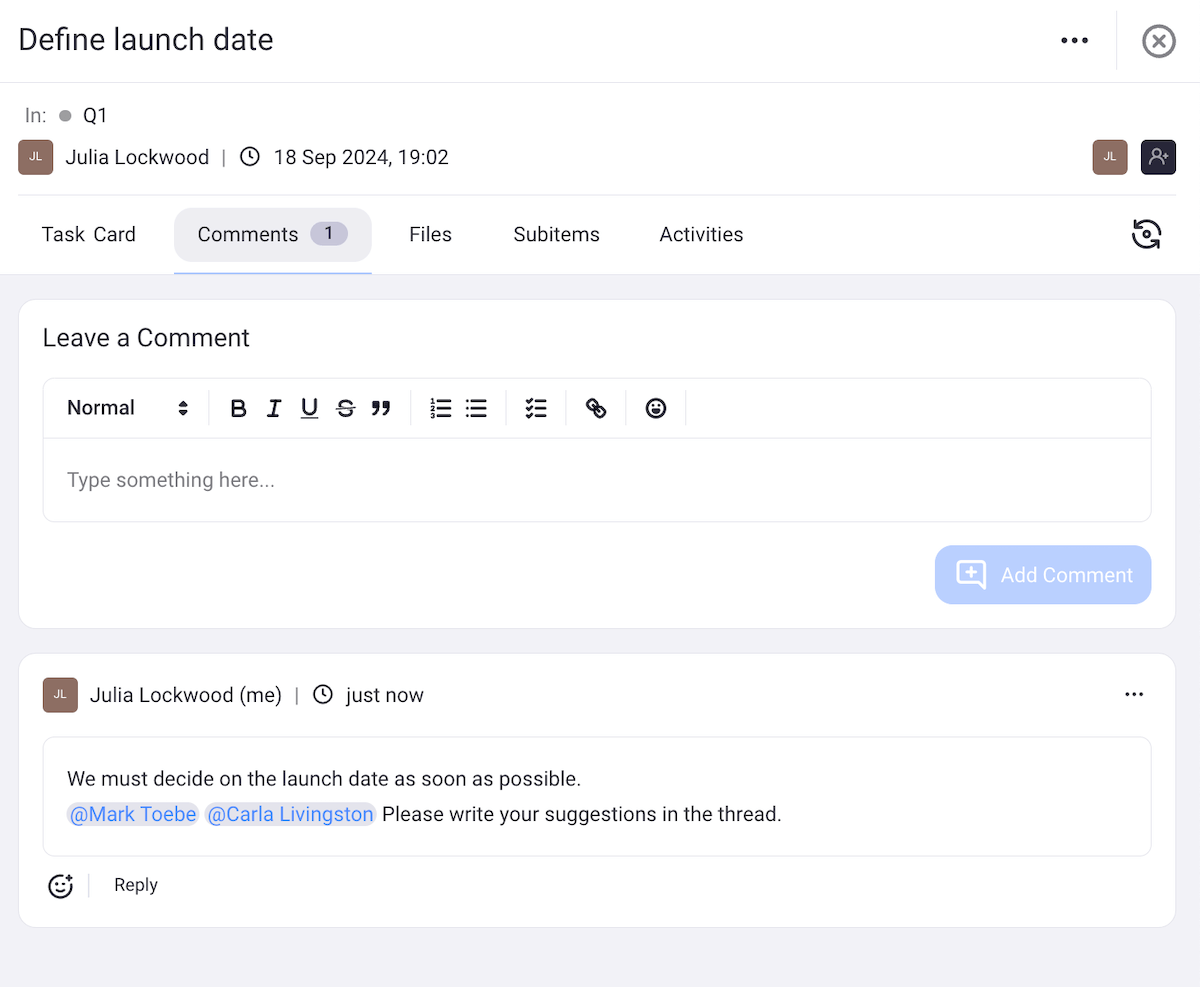
Most importantly, Plaky offers a secure space for all your product plans.
You already know that if information about your new product leaks before its launch, it could have catastrophic consequences. So, you must ensure that all your work is protected — no exceptions.
Luckily, Plaky has passwordless authentication, which means it’s inherently secure — no password = no password theft. Plus, you don’t have to rely on your employees to think of strong passwords (and remember them!). Instead, you can all log in with an OTP (one-time password) that’ll be sent to your email.
In addition, Plaky is SOC 2 Type 2 and ISO/IEC 27001:2013 certified, as well as GDPR compliant. So, your data is safely stored at all times.
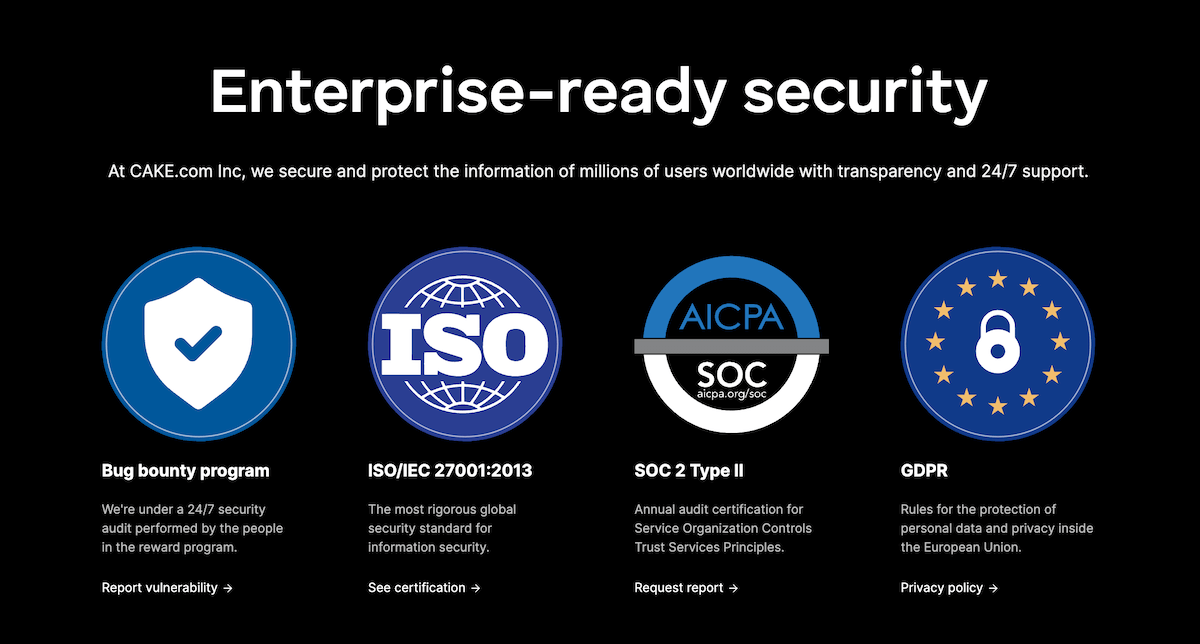
And guess what? Scalability isn’t an issue either.
As your projects and launches become bigger and greater, Plaky provides you with all the tools you need for sustainable growth.
In fact, Plaky enables you to create boards for your projects, customize them to your business needs, and share them with an unlimited number of users — even on its free plan.
And for advanced features and limit-free product launches, Plaky has 2 other paid plans that are sure to meet and exceed your expectations.
Bring structure and organization into your product launches. Create a free Plaky account today!
